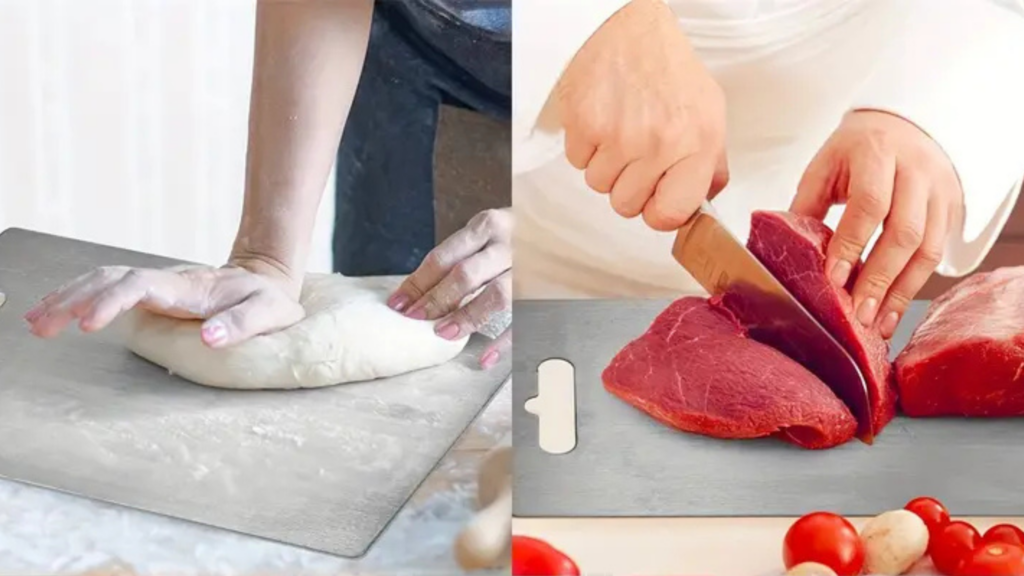Introduction
A cutting board is one of the most frequently used tools in any kitchen. Whether you’re slicing vegetables for a salad, dicing chicken for stir-fry, or prepping fruit for smoothies, your board sees it all. But here’s the kicker—if not cleaned and maintained properly, that same cutting board can become a hotbed for bacteria and a gateway to foodborne illnesses. Harmful pathogens like Salmonella, E. coli, and Listeria can lurk in the grooves and pores of your board, waiting to contaminate your next meal.
So, how do you ensure your board stays squeaky clean and germ-free? In this in-depth guide, we’ll walk you through everything you need to know—from choosing the right material to daily cleaning habits, deep sanitation, and even proper storage. No matter what type of cutting board you use—wood, bamboo, plastic, glass, or titanium—these practical tips will help you protect your food, your family, and your peace of mind.
1. Choosing the Right Cutting Board for Hygiene
Before diving into cleaning routines, it’s important to start with the right foundation: the material of your cutting board. Each type has its pros and cons when it comes to hygiene:
Plastic Cutting Boards
Plastic boards are widely used and often favored for their dishwasher-safe convenience. However, they are highly susceptible to deep knife grooves. These crevices can harbor bacteria even after washing, especially if the board is older and has been heavily used. If you opt for plastic, inspect it regularly and replace it when deep cuts appear.
Wood Cutting Boards
Wood is naturally antimicrobial, thanks to its ability to trap bacteria and eventually kill them off. However, wood boards can absorb moisture, which creates a breeding ground for mold and lingering bacteria if not dried properly. Regular oiling and proper drying techniques are a must for maintaining a safe wooden board.
Bamboo Cutting Boards
Bamboo is harder and less porous than traditional wood, making it a bit more resistant to knife marks. Still, it’s not immune to bacterial buildup. Like wood, it benefits from regular oiling and thorough drying.
Glass Cutting Boards
Glass is non-porous and ultra-easy to sanitize, but it comes with a catch: it can dull or even damage your knives quickly. For this reason, many chefs avoid it despite its hygienic properties.
Titanium Cutting Boards
Now we’re getting into the real game-changer: titanium cutting boards. These are the gold standard for kitchen hygiene—and for good reason. Titanium is naturally non-porous and antimicrobial, meaning it resists bacteria without the need for harsh chemicals or constant deep cleaning. Unlike wood or plastic, it won’t absorb moisture, warp, stain, or develop deep grooves that trap food particles. That translates to fewer cleaning hassles and a dramatically lower risk of cross-contamination. Titanium boards also boast exceptional durability, holding up to years of heavy use without compromising their integrity. They’re sleek, ultra-tough, and incredibly low-maintenance—perfect for any home cook or professional chef who prioritizes cleanliness and convenience. If you’re serious about keeping your kitchen germ-free, a titanium cutting board is more than just a tool—it’s an upgrade. Check out the premium options at CHOP CHOP USA for a board that works as hard as you do, and lasts a lifetime.
2. Daily Cleaning Practices
Keeping your board germ-free starts with everyday cleaning. These steps might seem basic, but consistency is what counts.
- Rinse Immediately
Don’t let food residues sit and dry on the board. As soon as you’re done chopping, give your board a quick rinse under warm water to remove food particles and surface bacteria. - Use Dish Soap
Scrub your cutting board with dish soap and a sponge or bristle brush. Pay extra attention to any knife grooves or textured areas where gunk might hide. - Rinse Thoroughly
Make sure to remove all soap residue, especially if you’re using the same board again soon. Soap buildup can affect the taste and safety of your next ingredients. - Dry Completely
Use a clean towel to wipe off excess moisture, then allow the board to air dry vertically. This minimizes the risk of bacteria thriving in trapped moisture.
For titanium or glass boards, you can often get away with just a quick soap and rinse, thanks to their non-absorbent surfaces.
3. Deep Cleaning and Sanitization Methods
While daily cleaning tackles surface grime, deep sanitization is necessary at least once a week—or immediately after handling raw meat, poultry, or seafood. Here are some effective and safe methods:
1. White Vinegar Solution (Natural & Gentle)
- Mix equal parts white vinegar and water in a spray bottle.
- Spray over the entire surface and let it sit for 5–10 minutes.
- Rinse with warm water and dry.
- Ideal for wood, bamboo, and plastic.
2. Hydrogen Peroxide (Antibacterial Powerhouse)
- Use 3% hydrogen peroxide directly on the board.
- Spread it with a sponge and let sit for 5 minutes.
- Rinse thoroughly and dry.
- Safe for most materials, though test first on wood.
3. Bleach Solution (Heavy-Duty Cleaning)
- Mix 1 tablespoon of bleach per gallon of water.
- Submerge or wipe down the board, let sit for 5 minutes.
- Rinse multiple times and dry completely.
- Only use on plastic or non-porous boards—never on wood or bamboo.
4. Lemon and Salt Scrub (Deodorizer + Disinfectant)
- Sprinkle coarse salt over the board.
- Cut a lemon in half and scrub the board using the cut side.
- Let sit for 5–10 minutes before rinsing.
- Excellent for wood and bamboo boards; refreshes smell and look.
4. Preventing Cross-Contamination
Even if your cutting board is sparkling clean, using it improperly can undo all your hard work. Cross-contamination is one of the most common causes of foodborne illness—but it’s also entirely preventable.
Use Separate Boards for Different Foods
Keep at least three cutting boards in rotation:
- One for raw meat/poultry/seafood
- One for vegetables and fruits
- One for cooked foods or bread
Color-Coded Boards
Color-coded sets make it easy to prevent mix-ups. Red for meat, green for veggies, yellow for poultry—whatever system works for you, stick to it consistently.
Sanitize After Raw Food Use
If you’re only using one board and prepping multiple foods in a row, always wash and sanitize thoroughly after cutting raw meat before using the board again.
5. Proper Storage to Avoid Germ Growth
Even a clean board can grow bacteria if it’s stored incorrectly. Here’s how to store it the right way:
- Keep It Dry: Always dry your board thoroughly after washing. Damp boards are prime environments for bacteria and mold.
- Store Vertically: Allow air to circulate by storing the board upright. This also helps avoid warping.
- Avoid Enclosed Spaces: Don’t stash your cutting board in a dark cabinet while it’s still wet. Trapped moisture can lead to mildew and funky smells.
- Don’t Stack Damp Boards: If you have multiple boards, make sure they’re all bone dry before stacking them. Bacteria love moist, hidden layers.
6. When to Replace Your Cutting Board
Cutting boards have a lifespan, especially wood and plastic ones. Here’s how to know when it’s time to say goodbye:
- Deep Grooves: If your board has many deep cuts that are hard to clean, bacteria could be living in those grooves.
- Lingering Odors: A board that still smells even after a deep clean is probably harboring bacteria.
- Stains or Discoloration: Stains can indicate that food particles or bacteria have seeped into the material.
- Warping or Cracks: A warped board wobbles during use, creating a safety hazard.
If you’re tired of replacing your boards frequently, consider switching to a titanium cutting board. With no absorption, no staining, and extreme resistance to wear and tear, they’re built to last for years—maybe even decades.
7. Extra Tips for a Germ-Free Kitchen
Want to go above and beyond? These bonus hygiene habits will take your kitchen cleanliness to pro levels:
- Use Food-Safe Mineral Oil: Wood and bamboo boards benefit from regular oiling to seal the pores and extend their life.
- Avoid Dishwashers for Wood: High heat and moisture can warp wooden boards. Hand wash only.
- Inspect Your Boards Weekly: A quick visual and smell check goes a long way in spotting problems early.
- Upgrade When It Makes Sense: If your cutting board is more than 5 years old and showing signs of wear, consider upgrading to a titanium board—your health (and your knives) will thank you.
Conclusion
Keeping your cutting board 100% germ-free isn’t rocket science—it’s about using the right materials, practicing smart cleaning routines, preventing cross-contamination, and storing it properly. By staying vigilant and treating your cutting board as a vital tool for health, you’ll not only improve your kitchen hygiene but also the overall taste and safety of your meals.
If you’re ready to make the leap to a premium, hygienic, low-maintenance board, check out CHOP CHOP USA’s titanium cutting boards. They’re engineered for cleanliness, built for performance, and designed to last a lifetime.
Got a favorite cleaning hack or cutting board care tip? Drop it in the comments—we’d love to hear from you!
And while you’re here, don’t forget to browse our selection of titanium boards and matching kitchen tools for a safer, cleaner cooking experience.
Stay sharp. Stay clean. CHOP CHOP!


